With all the various synthetic monitoring software out there, determining what is appropriate for you is difficult. You know you want to mimic user activity with websites and apps to monitor performance and availability, but you need to determine what tool is ideal. I’ve got you covered!
In this article, I’ll make selecting the best option for you easy, with my own experience using dozens of various synthetic monitoring tools with multiple teams and projects, including my selection of top synthetic monitoring software.
What are Synthetic Monitoring Tools?
Synthetic monitoring solutions are applications that simulate user actions on web pages, apps, or services. Synthetic monitoring solutions create and execute scripted steps and flows that replicate real-user activities, such as clicking a link, filling in forms, or navigating through a website.
The fundamental purpose of synthetic monitoring is to automatically test and track the responsiveness and availability of online services while keeping them operational. These kinds of tools are best utilized in discovering and diagnosing website or application monitoring performance, availability, and user experience problems.
Through scripted interactions, synthetic monitoring tools can offer standardized and continuous observations of how a system performs independent of real user traffic. Such an approach is beneficial in testing new functionality, measuring performance under various conditions, verifying that the essential functionality of web services remains up and running, and offering a best-of-breed user experience.
10 Best Synthetic Monitoring Tools
1. Site24x7
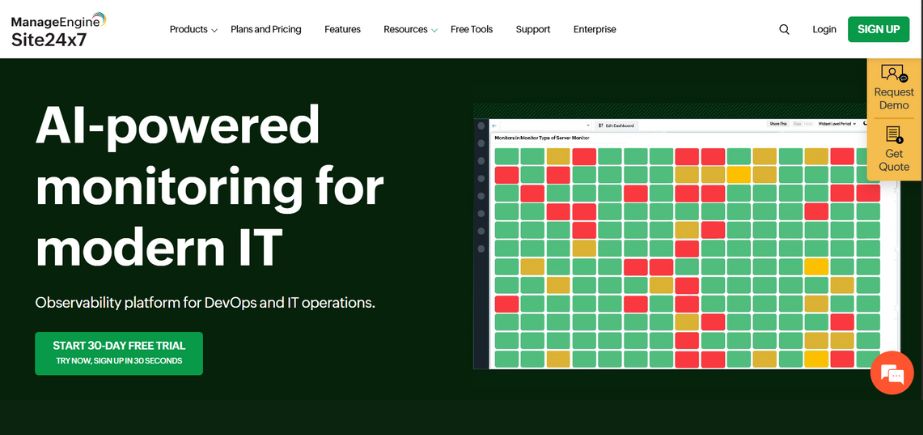
Site24x7 is one of the best synthetic monitoring tools that mimics user interactions to measure the performance and availability of your websites, applications, and APIs. Mimicking normal user actions, it allows you to detect and fix potential problems before they affect actual users.
It has been ranked and awarded on numerous review websites such as Capterra, Software Advice, GetApp, and G2 as a Top performer, Category leader, leader in AI network monitoring, and so on. It has been relied upon by several well-known names such as Trigo, Croma, Lindsay, BPP, IIFL Finance, and many others.
Features:
- A network that is visible, managed, and has more precise control
- Improved security.
- Minimize network downtime.
- It prevents network failure and cuts down costs.
- It also includes SDN/SD-WAN monitoring, network configuration management, and network traffic monitoring.
- Automated network configuration and change management.
- Device templates, health dashboard, network mapping, and much more.
Pros:
- In-depth network analysis. Detects anomalies instantly.
- Secured, friendly firewall architecture.
- It ensures uptime.
- SNMP trap processing
- Multi-vendor support.
Cons:
- Overalerting on larger outages
- Complex set-up
Price:
- Pricing options come in yearly, monthly, and hourly models.
- It starts with $9 per month.
- A free trial of 30 days is offered.
2. ManageEngine Applications Manager

Maximum server and application performance and availability can be ensured with ManageEngine Applications Manager, an enterprise-grade application performance management solution.
Applications Manager uses machine learning-based algorithms to identify anomalies in application and server performance automatically.
This enables it to learn from past performance data and recognize deviations that may signal potential problems before they affect service levels. This is proactive monitoring, which is not as heavily featured in most other similar tools.
Features:
- Mirror end user experiences on websites and applications to measure their performance accurately.
- Implement End User Monitoring agents to collect performance intelligence from different locations geographically.
- Have in-depth analysis of critical measurements such as DNS resolution time, page size, page response time, etc.
- Get more insights into your digital infrastructure with a particular focus on aspects like email servers, web servers, REST APIs, etc.
- With a very reliable fault management system that can directly trace the root cause of any error or fault.
Pros:
- The ability to design and track custom scripts is a major plus
- Offers comprehensive performance statistics and advanced diagnostic features
- Supports a vast array of applications, servers, databases, and cloud platforms
Cons:
- Though feature-rich, the interface may be daunting for new users
- Setting up and configuring a tool initially might be challenging.
Price:
- 30-day free trial
- Pricing on request
3. Freshping
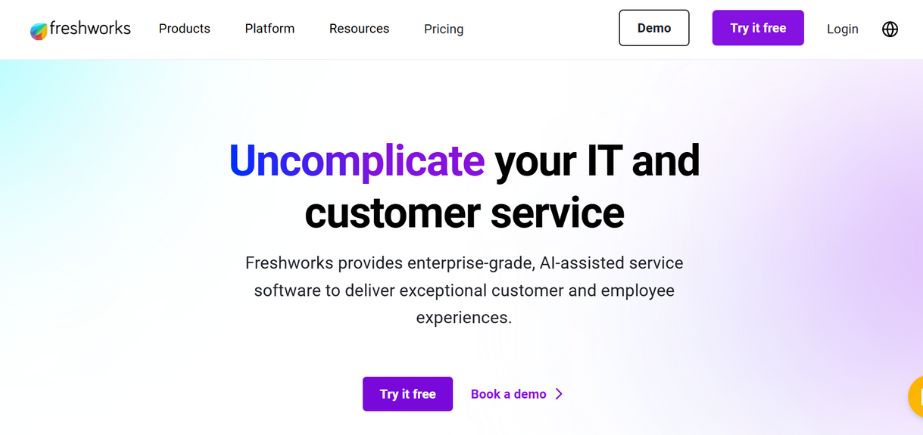
Freshping is a free website monitoring tool. It offers detailed monitoring reports to enable you to understand website downtimes or performance problems at a glance.
It’s gratis and can assist you in monitoring HTTP/HTTPS URLs, web sockets, ICMP Ping, TCP, UDP, and DNS from 10 places worldwide.
You have the versatility of getting alerted through the channels that suit your team using this tool. Webhooks can be configured to create a tailored channel of notification that your team is familiar with or that best suits your business.
Features:
- For codeless test creation, Datadog has the feature of Web Recorder.
- It also includes continuous, automated testing, so you can continue to detect problems in off-hours.
- Datadog also includes advanced alerting features that notify the team of issues without generating false positives.
- It can monitor SLAs and SLOs.
- It includes simple sorting and filtering with tags.
Pros:
- Interactive data visualization graphs
- Automatic service discovery and setup
- Live, detailed performance monitoring
Cons:
- It can be time-consuming to optimize its features
- Reporting and analytics features might be more robust
Price:
- Free demo
- $4.50/node/month
4. Sematext
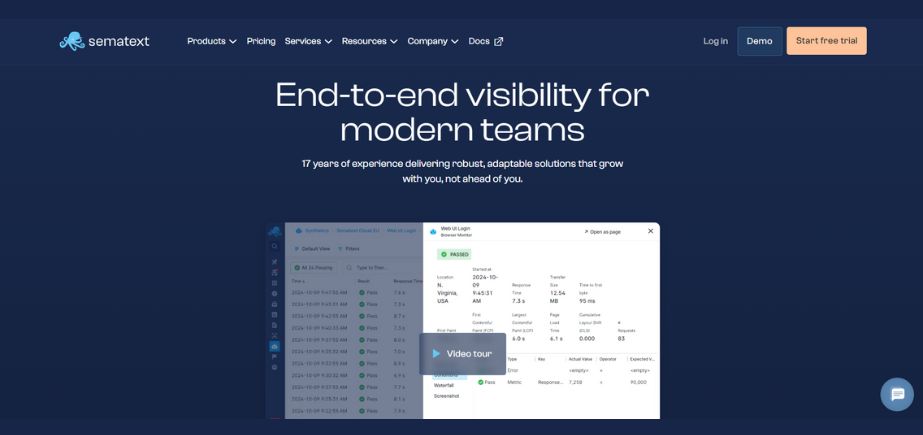
Sematext provides logs, monitoring, experience, and synthetics products. Sematext Synthetics will assist you with rapidly delivering consistent & reliable websites and APIs. It contains synthetic testing and monitoring tools for monitoring APIs and business-critical transactions, as well as a website’s availability.
Features:
- Sematext is able to do uptime and API monitoring from various locations, private networks, behind firewalls, etc.
- It can monitor network timings at all layers (DNS, TCP, SSL, & HTTP).
- For Web Performance Monitoring, it can capture page load time, monitor web vitals & third-party & SLAs, and identify web performance problems, etc.
- It supports different functionality, like SSL Certificate monitoring and end-to-end visibility.
Pros:
- Simple to start
- Many monitoring capabilities
- Affordable pricing
Cons:
- The reports are tricky to interpret
- Tech support’s response is sluggish
Price: The cost of Sematext Synthetics begins at $2 per monitor.
5. New Relic

You can test and optimize your code with New Relic’s features. Throughout the life of your product, you can use the tool to replicate user behaviors on your web application on various devices.
By actively identifying underperforming components like as URLs, APIs, and services, it helps you fix issues before they negatively impact the user experience of your clients.
By providing you with the monitoring suite you need to diagnose your stack more quickly, New Relic gives you a head start. It helps you pinpoint the problem so that you can swiftly raise the caliber of your creations.
Features:
- A tool for measurements, events, logs, and traces is the Telemetry Data Platform.
- It can operate on a petabyte scale, at millisecond speed, and pennies per gigabyte.
- It provides full software stack visibility.
- Real-time anomaly detection and insight extraction are possible with New Relic.
Pros:
- Collaboration features
- Pricing flexibility
- Start for free
Cons:
- Improve UI
- Some configurations are fiddly and not intuitive
Price:
- Free trial + free demo
- Pricing on request
6. Zabbix
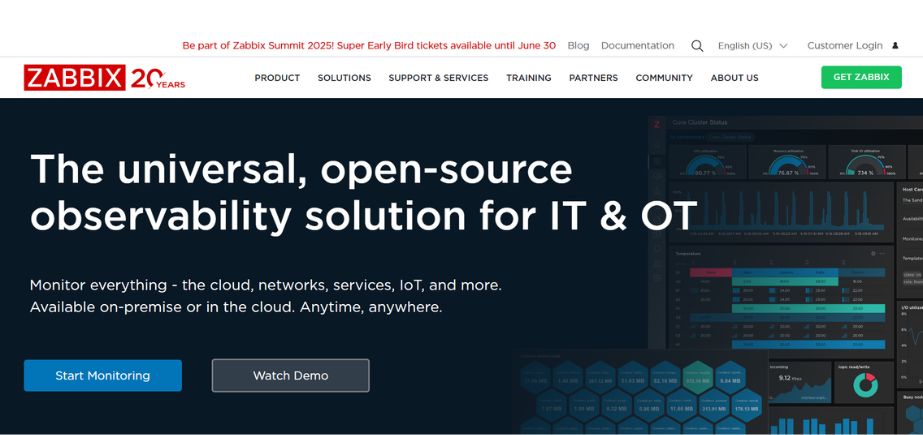
As an open-source program, Zabbix provides a range of monitoring features, including database, cloud, server, network, and container monitoring. You may visualize or keep an eye on your whole IT infrastructure stack with its all-in-one solution.
This software excels in business service monitoring. It assists you in monitoring KPIs by giving you insight into your product’s performance. It has root cause analysis capability, which enables you to identify where the issues are so you can resolve them promptly.
Features
- It provides waterfall reports that will help you identify the cause of the slowdown.
- It provides the feature of seeing HTTP headers on an element-to-element basis.
- It supplies facilities for testing a website’s core features, such as a shopping cart and payment page.
Pros:
- Freely available
- Extremely secure
- Scalable
Cons:
- Low level of customization
- More elaborate tutorials or guides are required
Price:
- Free trial offered
- Pricing on request
7. Better Stack
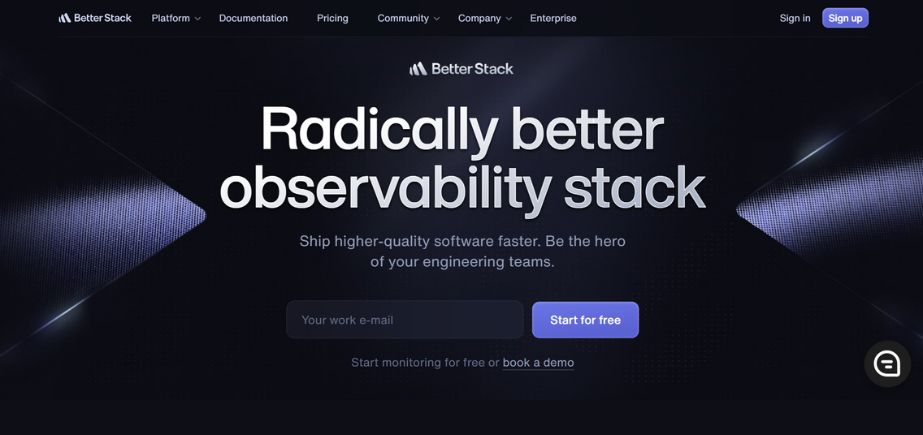
Better Stack is one of the best synthetic monitoring tools that allows you to avoid downtime and performance problems by giving you visibility into your stack. It has the features you require to debug problems and close incidents with confidence.
Better Stack assists you in avoiding downtime by offering synthetic monitoring features, such as uptime monitoring and log management. The software allows you to monitor, log, and troubleshoot anything. You can visualize your entire stack, organize your logs in a clean way, and have the clarity you require to debug issues and resolve incidents promptly.
Features
- It is able to do page speed analysis.
- For transaction monitoring, it can be used to test basic or complex transactions.
Pros:
- Customizable features
- Solve incidents more quickly
- Free to get started
Cons:
- There are some complex settings
- Documentation should have more content
Price:
- Free plan available
- Starting from $30/user/month
8. Uptrends
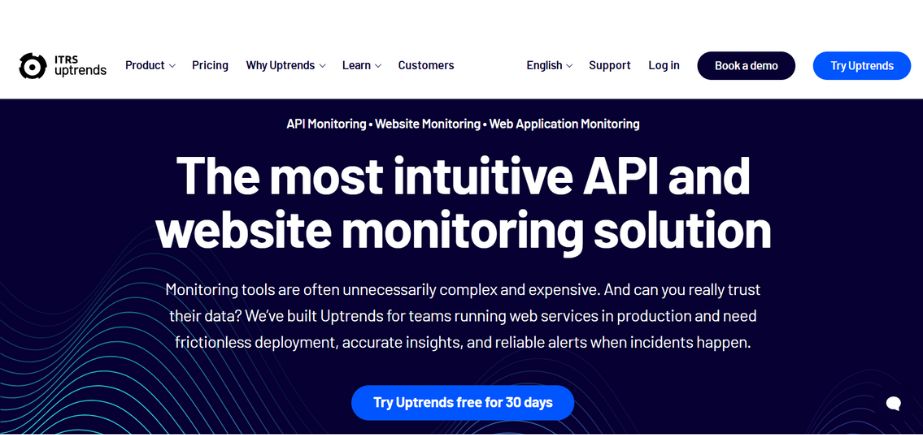
Website, web application, and API monitoring are examples of synthetic monitoring tools offered by Uptrends. You can test your website using the program from up to 233 different locations across the globe.
This device assists you in enhancing your web performance with its real browser web performance tracking.
It enables you to conduct website performance tests from 233 different locations around the world. Uptrends opens a genuine browser from one location you’ve selected and emulates user sessions on your sites exactly as a real user uses your site.
Features:
- Uptrends has features for creating data transfer with simultaneous monitoring. It is capable of simultaneous monitoring for three or more sites.
- Uptrends records the detailed performance statistics after the page has been tested.
- It has waterfall reports, which will enable you to find the reasons behind the slowdown.
- It offers the facility of inspecting HTTP headers element-wise.
- It possesses features for verifying the fundamental functions of a website, including a shopping cart and payment screen.
Pros:
- Real-time user insights and notifications
- Excellent customer support
- Good value for the cost
Cons:
- User management capabilities need improvement
- The UI needs to be more intuitive
Price:
- 30-day free trial
- From $15/user/month
9. UptimeRobot

UptimeRobot is an innovative all-in-one uptime monitoring tool. The software helps you monitor your assets or products wherever you are. You’re notified if things go wrong!
You can monitor all your digital assets under one roof with this software. It has various monitoring options, such as website, SSL, ping, port, cron job, and keyword monitoring.
UptimeRobot enables you to perform multi-location checks. The tool allows you to keep your stakeholders and team members in the loop by inviting them to view your monitors and receive notifications of incidents.
Features
- It offers the ability to replay programmed transactions with all of the mouse, keyboard, and screen interactions mimicking those of an actual user.
- The recorded business transactions can be executed in actual browsers.
- It can assess how well the website performs in comparison to the competition’s major pages and real-time transactions.
Pros:
- Friendly pricing
- Seamless integrations
- An all-in-one platform
Cons:
- Response times for customer service need to be shortened.
- Limited customization
Price:
- Free plan available
- From $5.50/user/month
10. eG Innovations
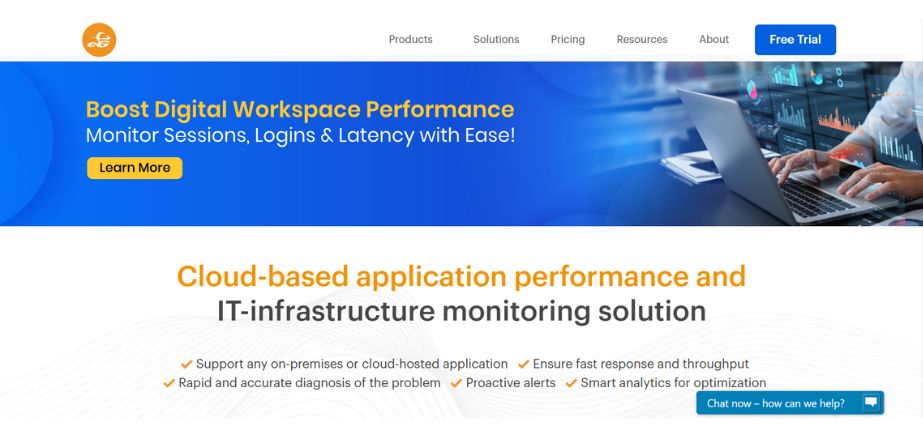
eG Innovations provides Synthetic Monitoring Services to track business transactions. It helps you troubleshoot problems linked to the user experience. It has cloud-based and on-premise deployment.
There are four methods adopted by eG Innovations in Synthetic Monitoring, Protocol Simulation, Web App Simulation, Digital Workspace Log-on Simulation, and Client Session Simulation.
Features:
- Protocol Simulation will include features of proactive tests, response time breakdown, tracking performance over time, and simulating multiple locations’ performance.
- Web App Simulation will provide functionality for simulating real-user behavior from various locations, recording of website up and down time, end-to-end response times, etc.
- Logon Simulator will offer you full visibility for proactive detection and problem determination of problems.
- For Client Session Simulation, it utilizes a record and playback engine based on OCR technology.
Pros:
- Simple to start with
- Multiple monitoring capabilities
- Affordable pricing
Cons:
- Reports could be difficult to analyze
- Slow technical support response
Price:
- There is a free trial for the platform.
Conclusion
Synthetic Monitoring tools and services actively and continuously perform the monitoring of business transactions. It aids in the pre-emptive identification of issues. For the active simulation of user transactions to IT applications, Synthetic Monitoring utilizes software robots and tests the performance and availability of those applications.
FAQs
1. What are the advantages of synthetic monitoring tools?
The advantages of synthetic monitoring software are to detect and correct issues early, baselining and benchmarking, monitor complex business processes and transactions, and uphold user experience.
2. Who are synthetic monitoring tools for?
Software testers and quality assurance teams employ synthetic monitoring solutions in order to observe applications so they can work the way they’re supposed to. And when they do have issues, they trust synthetic test outcomes to correct issues and improve the product’s performance.
3. What are the 3 types of synthetic monitoring?
The three major types of synthetic monitoring are web performance monitoring, availability monitoring, and transaction monitoring.

